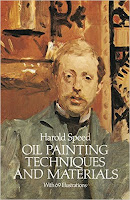 Today we'll continue Chapter 9: "Painting from the Life" from Harold Speed's 1924 art instruction book Oil Painting Techniques and Materials
Today we'll continue Chapter 9: "Painting from the Life" from Harold Speed's 1924 art instruction book Oil Painting Techniques and MaterialsI'll present Speed's main points in boldface type either verbatim or paraphrased, followed by my comments. If you want to add a comment, please use the numbered points to refer to the relevant section of the chapter.
Today we'll cover pages 173-180 of the chapter on "Painting from the Life," where he talks about Sir Joshua Reynolds, Thomas Gainsborough, Frans Hals, and Rembrandt van Rijn.
 |
| Sir Joshua Reynolds unfinished portrait |
1. Reynolds executed his portraits in monochrome and then glazed the color over it.
The unfinished portrait above shows how his portraits must have looked in progress.
2. Reynolds' business approach for portraits
He'd charge half on commencement and the second half on satisfaction. But "he had a room full of rejected portraits in his house when he died." According to Speed, he produced 150 portraits per year.
3. "The smaller the source of light, the less half-tones you get."
Sharp, small lights create a sharp division of light and shadow. Soft light, which comes from large light sources (large windows or exposure of sky) leads to a more gradual shift from light to shadow.
Speed argues that smaller sources are more flattering, but that's generally not the consensus among portrait painters and photographers. Photographers of women in particular routinely use softer or more diffused lights, that is lights that emanate from a larger area. This soft light downplays highlights and unwanted lines and texture in the halftones.
4. Simplifying the modeling will flatter a face, even without changing the features or proportions at all. Powdering has the same effect by reducing highlights.
"The artist is not obliged to catalogue all these details." He says that a "mean vision," (meaning one that focuses on small, trivial forms) misses out on the larger, nobler vision.
I think what Speed is recommending is using a relatively smaller source of light, but ignoring or downplaying the minor details of wrinkles and highlights.
 |
| Gainsborough The Painter's Daughters (with ghost cat) |
Gainsborough
5. Method: paint thinned with turps and linseed oil. Commenced by rubbing in with burnt umber cooled with terra vert (green).
This produces cool half-tones, into which reds and yellows are added into the lights, followed by darker accents. Note the drawing with the brush on the toned canvas. Also note the ghost cat.
In ateliers, the coloring of the first painting is called "dead coloring," and it is brought to life with warm glazes later.
6. "Swift unity of impression is one of the secrets of the charm, a thing that must always be caught on the wing."
Painting children is always improvisational, even in Gainsborough's day.
 |
| Hals 30 Year Old Man with a Ruff, London |
7. Spontaneous handling, painted with a simple palette. Painted with soft brushes, not hog hair (bristle). Speed speculates that a painting like the one above was accomplished in one sitting.
8. Blacks: thin painting over a warm ground.
Note the brushwork in the ruff. Speed notes that it was painted with a gradated middle tone into which he has flicked lights and darks.
 |
| Rembrandt Head of an Old Man |
9. Analyzing R. is more difficult because of his variety of handling.
Paint laid in with broken color and glazes, and sometimes with direct opaque handling. Generally Rembrandt reserves the thick paint for the lights, and keeps his darks smooth and transparent.
10. Color: "Rembrandt was a great master of getting the utmost variety out of a few earth colors."
That was true of most of the old masters. Ultramarine blue, so common today because it has been chemically synthesized, was more expensive than gold, and was usually reserved for the cloak of the Virgin Mary.
 Next week— Tone and Color Design
Next week— Tone and Color Design
-----
In its original edition, the book is called "The Science and Practice of Oil Painting ." Unfortunately it's not available in a free edition, but there's an inexpensive print edition that Dover publishes under a different title "Oil Painting Techniques and Materials
." Unfortunately it's not available in a free edition, but there's an inexpensive print edition that Dover publishes under a different title "Oil Painting Techniques and Materials (with a Sargent cover)," and there's also a Kindle edition.
(with a Sargent cover)," and there's also a Kindle edition.
----GurneyJourney YouTube channel
My Public Facebook page
GurneyJourney on Pinterest
JamesGurney Art on Instagram
@GurneyJourney on Twitter







7 comments:
Such a grand tradition, is painting! Wonderful Talent tugged and pulled by the vagaries of living life. How can you not feel grateful to be part of an artistic tradition when viewing Rembrandt's 'Head Of An Old Man'? Just yesterday I was looking for a frame for a painting in my studio and found an 11x14 framed photo I had kept but forgotten of Michelangelo's 'Pieta'. So stunning to witness again the folds of Mary's dress hewn out of marble, or her delicate, outstretched fingers, all without power tools! Plus, the outpouring of talent and tenacity leaves behind a visual recording of history for us to continually admire and to gain a longer perspective from our place in the chain. Sorry, perhaps not on point, but this entry provoked me into a spasm of appreciation.
Sesco, I'm glad you waxed philosophical. As I was looking at those examples and thinking about Speed and his predecessors, I was imagining the artist's life before the burdensome blessing of our modern technology. I thought about a quiet room with Rembrandt talking softly to an old man, and Gainsborough cajoling those squirming kids to hold still for one minute longer....
What a fine journey into the
"backward abyss of time"
;o)
Reynolds, for instance, having "had a room full of rejected portraits":
These darlings still must have been dear to him. Would he not otherwise have disposed of those failures?
Tis a wonderful thing to have this dialogue with the dead. Age old craft does that. I work as a stone mason and recently discovered my great great grandfather did too. Having seen some of his work, I was delighted to be able to pick up some tricks from his technique and was shocked to see we have a similar style. Wish I could say that about Gainsborough who has been a long time hero of mine. Wonderful man and technique. He was indifferent to the portrait business and only ever really wanted to do 'landskips'. A bloke can learn a lot from his trees. Such vitality! On his portraits - he would roll up the canvas so the face he was working on was close to the edge of the easel. This made it easier to 'sight size' the portrait.
Thanks for the article James.
HI, Thanks for sharing such wonderful images. For a Portrait photographer these are really helpful.
Hi James, Thank you for listing amazing tips and content on your blog posts. I've become a new fan!
wow! amazing post..big thanks from ML Photo and Design... you can see more work ...simply Click Here
Post a Comment